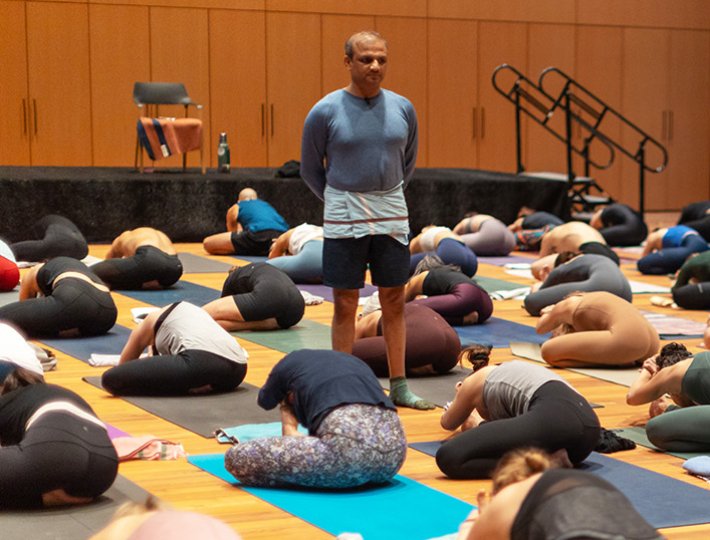You know ashtanga as the physical form of yoga practice that has become famous in studios and gyms around the world. But what you may not know is that aṣṭāṅga refers to much more than just a series of postures and breathing. Aṣṭāṅga literally means ‘eight limbs’ or ‘eight parts’ and refers to eight different aspects of yoga practice defined by the great sage Patañjali as a method for reaching the “state” of yoga.
Prior to defining the eight limbs, Patañjali tells us that “by practicing the limbs of yoga, the impurities are gradually removed and the inner light of wisdom is revealed, leading to perfect discrimination.” In order to reach the state of yoga, you must first purify your system through yoga’s limbs. The first four limbs should be practiced diligently in order to move beyond them and experience yoga’s essence—a state of mental and spiritual clarity that allows you to reach your highest potential.
Patañjali defines the limbs of ashtanga yoga as yama, niyama, āsana, prāṇāyāma, pratyāhāra, dhāraṇa, dhyāna and samādhi although commentators explain that only the first four limbs can be truly practiced while the last four arise as a result of diligent practice of the first four. This article briefly describes each of the eight limbs, and subsequent pieces will explore each limb in depth.
The Eight Limbs of Yoga
Yama are social observances. They are the way that we regulate our behavior in relation to others. There are five yamas and when practiced perfectly, Patañjali calls them “the great observances.”
1. Ahimsa is non-violence.
2. Satya is honesty or truthfulness.
3. Asteya means not stealing.
4. Brahmacarya is the controlling of sexual energy in order to follow the higher pursuit of yoga.
5. Aparigraha literally means non-grasping.
Niyama are personal observances. They are observances that are important for progression on the path of yoga. There are five niyamas.
1. Śauca means cleanliness or purification and is made up of bahir śauca (external purity) and antaḥ śauca (internal or mental purity).
2. Saṃtoṣa means always being content with your situation.
3. Tapas literally means work or heat and is the effort we apply to yoga practices.
4. Svādhyāya is self study. You should apply yourself diligently to understand the teachings of yoga that have been given by your teacher.
5. Īśvarapraṇidhāna literally means depositing yourself in Īśvara, the supreme soul. It is an understanding that there is a higher power.
Āsana is the third limb and refers to the āsanas that are practiced in yoga. Patañjali gives no detail about the practice of āsanas apart from the qualities which you should aim to find within them and the results of practice. He states that you should be steady and comfortable and should aim to eliminate all unnecessary tension, with only the amount of effort necessary to maintain the integrity of the āsana. He gives the example of ‘Ananta,’ symbolized in Indian mythology as a great snake lying coiled on the cosmic ocean supporting the enormous weight of the universe and requiring great strength and stability.
Even while supporting this enormous weight, Ananta has the qualities of comfort, peacefulness and serenity. Patañjali says that as result of attaining these qualities in āsana, you will no longer be disturbed by ‘pairs of opposites’, meaning that you will maintain equanimity in hot or cold, happiness and sorrow etc and will have mental equilibrium at all times, untroubled by anything that life presents you. This is extremely important and is the essence of true yoga practice. It is not the difficulty of an āsana that is important but whether the mind can remain undisturbed at all times.
Related: The Meditative Magic of Tristhāna in Ashtanga Yoga
Prāṇāyāma means regulating and controlling the breathing. There are thousands of different prāṇāyāmas of which a few are useful. Before you practice these prāṇāyāmas, you should first purify and stabilizes the body and mind through āsana practice with a focus on deep and even diaphragmatic breathing. The breathing technique used during āsana practice is, in fact, a simple prāṇāyāma. Its consistent practice gives profound results on the physical and mental level. Due to its powerful nature, more advanced prāṇāyāma should only be learned directly from a qualified teacher. It has the capacity to cure many diseases, but practiced incorrectly can cause many diseases. Once prānāyama is mastered, however, it is said to reveal the inner light, a necessary preparation for the final three limbs of aṣṭāṅga: dhyāna, dhāraṇa and samādhi.
The last four limbs are pratyāhāra, dhāraṇa, dhyāna and samādhi. It is said that these four limbs arise naturally as a result of perfection of the first four when they have been studied and practiced continuously over a long period of time.
Pratyāhāra can be translated as withdrawal or purification of the sense organs. This means that the senses serve the mind faithfully and are under it’s control, rather than pulling the mind in unwanted directions. In perfection of pratyāhāra, Patañjali says there is complete mastery over the senses.
Dhāraṇa, Dhyāna and Saṃādhi: The last of the three limbs begins with dhāraṇa, which is the ability of the mind to focus entirely in a single direction. Dhyāna, commonly translated as meditation, is when your mind is then able to hold the object of attention without any break or interruption, remaining continuously focused on the object. Samādhi is described as complete absorption of the mind with the object of focus, as if the mind takes the form of the object and in which you lose awareness of your own identity and then Patañjali says “only the form of the object shines.”
These last three limbs (dhāraṇa, dhyāna and samādhi) are a continuum of successively deeper concentration. Together, they form a process referred to as ‘saṃyama’ which can literally be translated as perfect control (of the mind.) The goal of yoga practice is to have perfect control of your mind with complete understanding of what you are engaged with, unaffected by previous conditioning. You can then operate from a higher consciousness, reaching your full potential, remaining in tune with the world and with your higher purpose.











Comments (0)